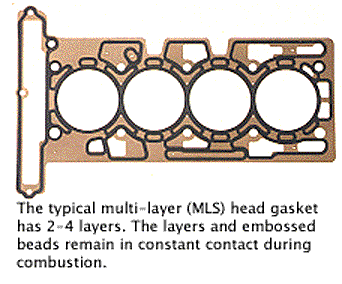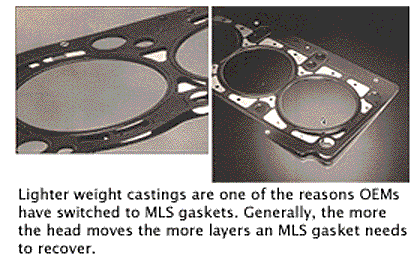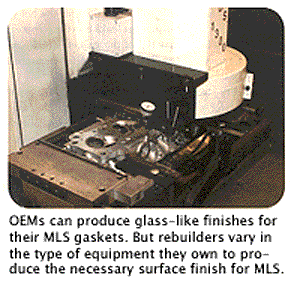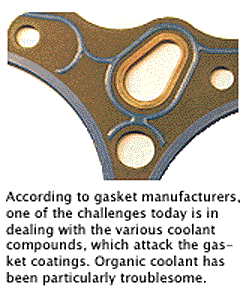Sealing an internal combustion engine has never been easy. In the last 100 years gasket manufacturers have tried many things, including paper, leather and even beef tallow, to try and seal the joint between the head and block.
Today, engine leaks are not what they used to be but can still be quite a headache for engine builders, especially if it means you have to warranty an engine due to a failed head gasket. Toward this end, gasket manufacturers have come up with new solutions to an age-old problem for engine builders.
We spoke with several leading gasket manufacturers about their latest solutions and philosophy to sealing the joint between the head and block. Most manufacturers said that the future is with multi-layer steel (MLS) gaskets. And while many still manufacture composite gaskets for older applications, the trend is clear that MLS is going to be supported by all the OEMs from here on out. Gasket manufacturers also point out that some applications are being retrofitted with MLS to solve inherent sealing problems.
Aftermarket vs. OE
According to major gasket manufacturers, nearly all the OEs have or will introduce MLS head gaskets on their new vehicles. Even GM, the remaining holdout from MLS, has gotten on the MLS bandwagon. While MLS technology is not really new, according to manufacturers there have been small improvements in the last year such as new types of rubber that go over steel layers. Each of the layers of an MLS gasket is either plain steel or coated with rubber over the metal. The rubber is more resistant to coolant and other chemicals and enables sealing on different surface conditions.
With regard to the latest developments in gasket technology, most manufacturers we spoke with say they don’t generally see changes in product design until the engine has been on the market for a few years and it reaches the aftermarket stage. One gasket maker says it’s typical to be a few steps behind the OEs until the engine starts to reach their customers’ shops.
Engine builders have different capabilities than the OEs when it comes to gaskets and surface finish. Some shops still use older equipment to machine heads and blocks. In the past, having a surface finish of 120-140 Ra was acceptable for sealing a composite gasket. When manufacturers design a gasket for the aftermarket they don’t look too much at how the OE did it, they are looking more at what is needed in the aftermarket. So some gasket makers use heavier, much more dense material than OE and they also open up the fire rings to accommodate the oversize bores.
MLS Construction

Multi-layer steel gasket constructions vary from manufacturer-to-manufacturer. Although MLS gaskets may look similar in design, each has its own unique design elements such as different coatings, embossments, stoppers and even removable layers.
Through advancements made using finite element analysis and the introduction of new materials, manufacturers have found that what they are really doing is balancing the joint between the head, the gasket in between, the block and the fasteners. The gasket has to be able to balance that joint effectively and make sure none of the components change that balance.
Finite element analysis, a form of computer modeling, is used by some manufacturers to aid in gasket design, and based on the power of the software, it allows manufacturers to monitor in real-time or in segments all the cycles of the engine. Manufacturers can take sections and simulate one cycle to evaluate the gasket in that cycle (e.g., when the piston fires) to look for sealing issues.
One of the keys to MLS is the ability for the gasket to recover and maintain contact pressure between the deck of the block and the cylinder head. Each time the cylinder fires it wants to push the head right off the block. So the key is the beads and the multiple layers. Think of it as a valve spring operating up and down, maintaining the contact pressure on the head.
Performance Gaskets

On the performance side, much higher cylinder pressures mean the head wants to lift off much more. Manufacturers say it’s critical to design a gasket for the application. In other words, manufacturers don’t simply make an MLS version of a previous gasket. Cylinder pressures, head movement and high temperatures all affect the design. A performance MLS gasket if installed correctly is a tough part to fail. To ensure that it doesn’t, one major gasket maker says a very important step is to pressurize the cylinder to see where the head lifts off the most. This helps designers determine the coatings and number of layers needed to seal that particular engine.
And no matter what you do to the bolt load you could still be relieving areas that will cause the cylinder head to leak, says another manufacturer. So the gasket must work with the hardware that’s available.
Traditionally performance gaskets have stiffer embossed beads, which is basically a flat piece of metal with rubber on either side that will be deformed in specific areas. The bead is actually what recovers. When the joint goes to separate it will naturally try and recover because of the beads and the steel recovering back to form. For performance MLS gaskets some manufacturers use stiffer beads so it can carry a greater load. Extra layers are used in many performance applications so there is a greater amount of recovery. Therefore, the more layers and embossed beading there is on a gasket to compensate for the greater amount of head lift the more the gasket can recover. The gasket will stay in contact with both the head and the block at the same time. This is what seals an MLS gasket. Manufacturers say traditional composite gaskets don’t have that recovery capability. If the joint separates with a traditional gasket it simply won’t continue to seal.
A stopper layer is used in many performance and the aftermarket MLS gaskets. There is virtually no difference between the way performance and the aftermarket use this layer. A stopper is one of the layers in the MLS part that is folded back onto itself. This folded area doubles the thickness of the layer around the combustion opening so when it is stacked up with the other layers it stops the embosses from becoming fully compressed. The stopper layer is the primary sealing point and if the head lifts enough to get past that the embossed beads recover the seal. One manufacturer noted that when you don’t fully compress the beads they last 70 percent longer and retain more of their recovery ability and the fatigue life is increased significantly.
Bi-Metal Engines

Bi-metallic engines have created new challenges for gasket makers, and MLS is an exceptionally good material for bi-metal engines, say industry experts. It allows the head to slide around but also has the added benefit of high tensile strength. Because of the steel inner layers, it’s very difficult to tear an MLS gasket apart. The MLS also helps maintain a more cylindrical bore. When you torque the head down onto the block the bolts pull up from the inside of the engine where the threads are and may warp the engine block. Warping can result around the bores and that, in turn, warps the surface. MLS gaskets provide a consistent amount of pressure around the top of the cylinder, and it helps prevent bore distortion when the head is torqued down.
With bi-metal engines, the aluminum is softer than cast iron and can brinell, which is the displacement of material in certain areas and can create a groove in the aluminum itself. This could be a concern if you have excess levels of thermal expansion or clamp load. Because aluminum is much more flexible, OEMs have reduced the amount of bolt torque required in today’s engines. With torque to yield (TTY) head bolts it is far more difficult to install the bolt incorrectly. Traditional head bolts can result in inconsistent torque values if there is dirt on the threads or they haven’t been cleaned or lubed with the right lubricant. However, with TTY you know you’re getting the right amount of torque. It has eliminated most of the ways to incorrectly torque the head, say industry experts.
Graphite Gaskets
One of the first real successful examples of sealing bi-metallic engines was conducted with the graphite head gasket. Graphite is basically a dry lubricant. When you put a graphite gasket between an aluminum head and iron block, however, they have vastly different rates of expansion. Graphite is very compatible with aluminum because it acts as a lubricant that the cylinder head can slide back and forth on without biting into the gasket or tearing the gasket. If you don’t have that sliding action it’ll dig into the gasket, say experts.

It’s important to note that if an application came OE with an MLS gasket then for the majority of applications you should replace it with another MLS gasket. There are some exceptions, however, such as the 2.6L Ford. We know that at least one manufacturer makes a set for that particular engine that contains a graphite composition gasket replacement for MLS. The reason for that is mainly for sealing purposes.
Though there are many up sides to MLS one of the difficulties in the past for engine builders using one of these gaskets has been the ability to achieve the proper surface finish for a good seal. MLS more than other types of gaskets require very smooth, flat surfaces in order to seal properly. OEMs can achieve very high levels of surface finish with Ra’s in the 8-10 range, however, engine builders vary in their ability to achieve this level of smoothness. But don’t worry: aftermarket gasket manufacturers have been hard at work developing head gaskets just for you, which are more conformable on a less than perfect surface.
With the MLS gasket you’ve got to have very straight flanges with a very flat and a smooth surface. So in applications like the 2.6L Ford the graphite will conform better if the flanges are not as straight and the surface is a bit rougher. The graphite will seal well and transfer heat well also.
Manufacturers say that in dealing with rebuilders one of the challenges is they don’t always know what kind of equipment shops are using. The head or deck finishing equipment may be 30 years old in some cases and therefore can’t quite achieve the surface finish needed for an MLS gasket.
The standard type composition gasket (i.e., graphite, asbestos, etc.) will fail much sooner when exposed to detonation and pre-ignition than an MLS gasket. In fact, an MLS gasket failure due to detonation or pre-ignition is quite uncommon, according to industry experts. A composition gasket under detonation/pre-ignition has a lot of shock pressure that will begin to dent the fire ring. What happens is the fire rings will fatigue under the shock. Just like if you take a tin can and bend it back and forth – it will break eventually. The same thing happens on the fire ring, the bending of the gasket over and over, eventually it splits and then all the hot combustion gas leaks into the composition material of the gasket, which cannot handle that kind of temperature and pressure and it burns up.
Do some rebuilders use a graphite gasket where they should use an MLS? The answer is probably yes, however, while the graphite part will certainly be more forgiving to surface finish and flatness, all the other variables – like cylinder head lift, lateral movement, loss of clamp load and bore distortion – make many reasons to stick with the MLS gasket.
Some industry experts warn that if you go from MLS backward to another type of gasket, everything the OE has done to tailor the head and block with the MLS in place will be undone. The OEs put bosses in certain areas and thicken up different components of the engine in order to keep the head as flat as possible under the preloaded conditions that the MLS gasket is providing. And if you change that, you’re really changing almost everything about what that gasket needs to do. Can you do it? You probably can, but there are issues with long-term durability as well as many others.













